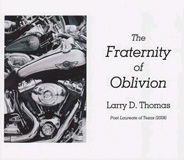 Review By Robert Neely
Review By Robert Neely
THE FRATERNITY OF OBLIVION
by Larry D. Thomas
Timberline Press.
6281 Red Bud, Fulton
Missouri, 65251
ISBN#: 978-0-944048-44-3
48 pp., $15.00
www.timberlinepress.com
One of the hardest traits for a poet to find in his work is originality. Most must begin with not only something to compel the reader to continue, but to compel the reader to continue this particular collection over others. Larry D. Thomas provides just this in the subject of his recent collection, Fraternity of Oblivion. In Fraternity, Thomas features poetry on and about the outlaw biker, a subject he brings to light with both beauty and violence.
Thomas has not forgotten to start off with a hook. The first poem, “Rite,” opens the collection with a scene where an inductee biker must allow “his woman” to be shared with the brothers of the pack:
and their sheep-woman
rising from the dunes,
sown with the rich,
chapter seed
of blood brethren.
Thomas, using his background in the criminal justice field, has a knowledge of and respect for the outlaw biker. The first section of his poems is dedicated to the loyalty of the brotherhood at all costs, appropriately titled, “Just for the Colors.” The violence and sex, while not gratuitous or narrative, is very present. Men regain consciousness after being beaten with chains, wrecks are fatal, and the brotherhood seeks their own form of justice.
Another section of the collection, “Her Dazzling Reputation,” focuses on the lives of women involved with biker men, from dancers with affection for bikers alone to an underage girl who deceived her way into a biker’s camp bed. It is done with such beauty we are left asking for more deaths upon unusual morals. If Cormac McCarthy was the novelist for describing massacres, Thomas is the poet for the aftermath.
This is not to judge the poetry on content alone, but to point out the unique nature of the topic Thomas brings into literary art. Tattoos are animals on men’s backs, alive on and in them. Scars are symbols of loyalty, and killing is a proud act, just as one poem states a man’s hands “when his/ and the law’s/ were one.” Consider this excerpt from “Each a Wingless Black Angel,” where nude tattoos and dark colors are symbols of freedom:
Deep blue nudes
shudder in the moonburned flesh
of biceps
as they gulp down
their fresh, fat tablets
of speed.
They navigate
the shades of night,
each a wingless,
black angel
The stories behind the poems have a human quality to them. If they are not true stories, they very easily could be. Thomas does not take the subject out of context for a deeper meaning, but finds the sense of brotherhood, justice, and arousal within the common events. In no way do they become his fiction, but they stay his subject of admiration. All bikers have to do is back behind a car and Thomas can find a way to bring emotion and depth to the scene. A couple simply making out in the back of an approached car have conflicting feelings–the man fearful of the outlaws’ presence, the woman aroused by the danger.
The book itself is part of Thomas’ art. The first edition is a 6×10, the same dimensions as a motorcycle manual. The illustrations were designed by a tattoo artist and are zinc-cut imprints. The cover photo features a line-up of Harleys, focused on one with its brother-bikes consuming the background. It is hand-set letter-pressed.
While Hunter S. Thompson appropriately titled his work Hell’s Angels to reflect a living contradiction, Thomas brings such contradictions to emotions. Violence expresses love, the free animals ride an urban highway, and beauty is inked by scars. Whatever your take on violence or the rebels, Thomas’ Fraternity of Oblivion will bring familiar emotions to an unfamiliar subject as very few can do.
Comments are closed.